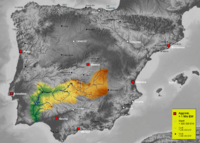Guadalupe (Spain) facts for kids
Quick facts for kids Guadalupe (Río Guadalupe) |
|
|---|---|

The watershed of the Guadiana
|
|
| Other name(s) | Guadalupejo |
| Country | Spain |
| Physical characteristics | |
| Main source | Sierra de Villuercas, Cáceres Province Extremadura 1,157 m (3,796 ft) |
| River mouth | Garcia de Sola Dam, Guadiana Valdecaballeros municipality, Badajoz Province 391 m (1,283 ft) 39°14′15″N 5°8′58″W / 39.23750°N 5.14944°W |
| Length | 40.56 km (25.20 mi) |
| Basin features | |
| Progression | Guadiana - Atlantic Ocean |
| River system | Guadiana |
The Guadalupe or Guadalupejo river (Spanish: Río Guadalupe) is a right hand tributary of the Guadiana, in Spain. The Francization of the toponym gave its name to the Guadeloupe island in the Caribbeans.
Course
The Guadalupe has its sources in the Sierra de Villuercas near Guadalupe, giving its name to the town, and by extension to the monastery of Santa María de Guadalupe.
It flows southwards into the Guadiana at the Garcia de Sola Dam, barely 1.5 km east of Valdecaballeros. There is an abandoned nuclear power plant, the Valdecaballeros Nuclear Power Plant, as well as a small dam near its mouth.
Etymology
The name is believed to be derived from the Arabic phrase وادي اللب, wādī al-lubb, 'hidden river', because the river narrows down as it flows near to the town of Guadalupe.
An alternative etymological explanation, which is commonly found on the internet, states that the name may have derived from the Arabic word for 'valley' or 'river' (wadi) and the Latin word lupus, meaning 'wolf'.
See also
 In Spanish: Río Guadalupe para niños
In Spanish: Río Guadalupe para niños

